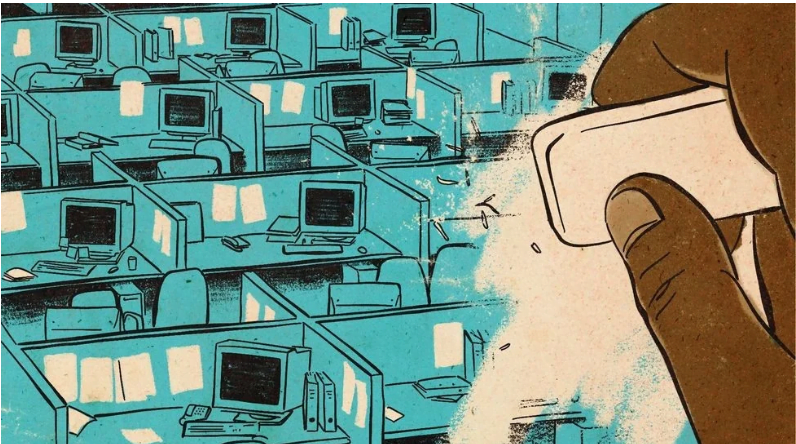Bustling skyscrapers and crowded offices were once a common sight in the pre-COVID-19 world. However, the COVID-19 pandemic has led millions of Americans to abandon their offices in favor of working from home. This shift is not merely a short-term response but rather a permanent change in lifestyle, especially with the rise of remote work even after the pandemic subsides.
The Shift to Remote Work
According to a survey by KPMG, a global network of professional firms, more than two-thirds (68%) of prominent CEOs plan to reduce their office spaces. The pandemic has shown that employees can succeed without being confined to cubicles or traditional office settings. This raises questions about the value of expensive office spaces, particularly in high-cost cities like New York, San Francisco, and Los Angeles. KPMG’s CEO, Paul Knopp, noted that home-based and virtual work environments have proven effective and productive.
As companies adapt to this new reality, they are investing heavily in digitalizing workplaces and supporting remote employees. Corporations are accelerating their shift to virtual models, which are here to stay. This trend includes increased use of automation and artificial intelligence to enhance productivity. The modernization and digitalization of the workplace, spurred by COVID-19, are driving companies to reconsider the need for expensive office space.
The Evolution of Office Spaces
Even before the pandemic, there was a growing movement towards remote work. The idea that expensive office spaces are becoming obsolete has gained traction, especially as businesses recognize the high overhead costs associated with maintaining physical offices. However, this doesn’t mean office spaces are entirely gone. Instead, they have evolved. The concept of virtual and digital office spaces has allowed companies to grow rapidly and capitalize on new opportunities.
While some businesses have thrived in the remote work environment, others have struggled or shut down entirely. With COVID-19 cases continuing to rise, remote work remains a focal point for companies looking to survive. However, the isolation and lack of in-person interaction have led many employees to miss the camaraderie of a physical workplace. For forward-thinking investors, these competing forces present attractive opportunities for investment.
The Continued Relevance of Office Spaces
Despite the shift towards remote work, office spaces are not destined to disappear. For instance, in mid-2021, when states lifted stay-at-home orders, companies cautiously allowed white-collar workers to return to office buildings. Although many employees worked from home during the pandemic, companies like Facebook, Google, and Morgan Stanley plan to continue offering telework options even after the crisis ends. Analysts predict that office spaces will still be necessary, especially in the short term, to accommodate social distancing requirements.
In the long run, companies will likely want most employees back in the office to foster collaboration and morale. The home, after all, isn’t an office and may not provide an adequate workspace for everyone. For example, in May 2020, Google provided employees with a $1,000 allowance to purchase home office equipment. However, this amount may not be enough to create a fully functional home office, and not all homes are equally equipped for remote work.
The Challenges of Home-Based Work
The sudden shift to virtual work has also highlighted disparities among employees. Those in managerial roles often have the resources to create comfortable home offices, while rank-and-file employees may struggle with limited space and equipment. These challenges suggest that office spaces will remain relevant, as they provide a more equitable work environment for all employees.
Conclusion
While the COVID-19 pandemic has accelerated the shift towards virtual work, it does not signal the end of office spaces. The advantages of physical offices, such as fostering productivity and collaboration, ensure they will continue to play a vital role in the business world. Instead of facing extinction, office spaces are evolving to meet new demands, becoming more affordable and essential than ever.
Even after outlining all the information above, writing a letter of intent (LOI) can still seem daunting. That’s why the Leveraged CRE Team at Commercial Properties, Inc. is here to help locate commercial space for lease and assist in using a letter of intent to land such space. Contact us at (480) 330-8897 or send us an email at request@leveragedcre.com.
Need assistance with your 1031 Exchange or DST? We’ve got you covered!
We’ve prepared a comprehensive, free e-book designed to guide you in achieving your long-term business goals or acquiring that dream property you’ve been eyeing.
Meet The LeveragedCRE Investment Team
Phill Tomlinson and Eric Butler are seasoned commercial real estate brokers with over 44 years of combined experience. They lead the LeveragedCRE Investment Team at Commercial Properties, Inc. (CPI) in Scottsdale, Arizona, specializing in investment sales and tenant/landlord representation across the Phoenix and Scottsdale submarkets.
The team leverages their extensive knowledge and expertise to help investors and property owners maximize their returns and navigate complex real estate transactions with confidence.
Stay informed with the latest in Commercial Real Estate strategies designed to enhance your income property investment results by bookmarking www.leveragedcre.com. Let us help you stay ahead in the market!
[i] https://home.kpmg/xx/en/home/media/press-releases/2021/03/nearly-half-of-global-ceos-dont-expect-a-return-to-normal-until-2022-ceo-outlook-pulse.html
[ii] https://home.kpmg/th/en/home/media/press-releases/2021/03/press-release-ceo-outlook-pulse-2021-en.html


